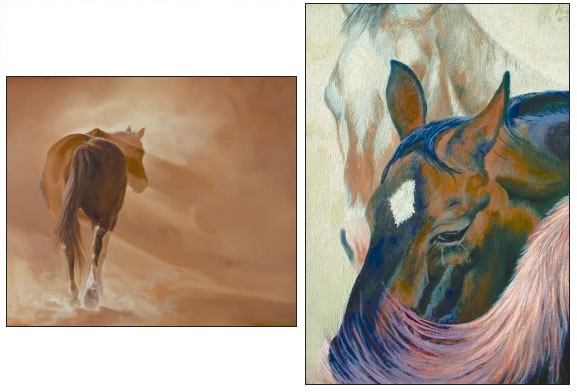Women have always had a special affinity for horses, and a unique mother- daughter show at the Edge of Cedars State Park Museum in Blanding, Utah, celebrates that bond.
“Desert Horses (Painted by the Women Who Ride Them)” features 35 equine paintings by Page Holland and her daughter, Sunnie Holland. The show is on display through January.

“GoIn Home” (left) an oil painting by Sunnie Holland of Moab, Utah, displays her fondness for depicting horses in beautiful, surrealistic landscapes. “Aging Gracefully” (right) is an acrylic painting by Page Holland, Sunnie’s mother, who focuses on more realistic images of horses. The works are part of an exhibit on display at Edge of the Cedars State Park Museum in Blanding, Utah through January.
“(Horses are) really beautiful animals,” Sunnie muses as she and Page discuss their exhibit by telephone. “You can paint them so many different ways. They have such a beautiful form.”
Neither Sunnie nor Page considers horses easy to draw. Coming at them with a sketch pad or camera causes them to either pose or run. “They turn their butt to you and ignore you,” Page chortles. “Just the act of staring at them affects them.”
Sunnie interjects that horses have strange shapes, with small feet, long legs, and interesting heads. “The perception of a horse isn’t always what it seems.”
Page adds, “You really have to go through a lot of film to catch the legs in the right position.”
Sunnie and Page love the challenge. Page grew up around horses in Crescent Junction, Utah, and considers riding her favorite activity. She and her husband camp and ride on BLM and state land around Moab, where they live.
Sunnie remembers watching horses wander the range back of her grandfather’s house in Crescent Junction. Later, she enjoyed the camping trips and rides with her parents through the Moab area’s “absolutely fantastic’ redrock landscape. As did her mother, she fell in love with the desert.
Page began drawing the desert at age 12. She taught Sunnie to draw and paint when the little girl began hanging out in Page’s studio. They’ve been discussing art ever since. Now, when something on Page’s canvas frustrates her, she turns to Sunnie for insight, and hopes Sunnie will do the same when she gets stuck.
A painting major in college who owns a framing business in Austin, Texas, Sunnie bubbles. “It’s really helpful to have another artist to help you see the world, things you may not notice.”
While they support one another, each woman has her own painting style. Page places realistic horses and riders against landscapes. “I have always been really fascinated with highly realistic works of others,” she explains. “It’s really important to me to make the people and animals have some life.”
Her work contains a strong element of design, which she attributes to a desire to create good compositions. “Photoshop and the computer have helped me to compose tighter pictures,” she says.
Once she decides how a painting will look, she begins by laying the colors she desires over their complements, or mixing values directly onto the canvas.
She admits that because she has worked so long amid red rocks, she has difficulty producing shades of green, and has challenged herself to learn to paint green en plein aire in the La Sal Mountains where she and her husband have property.
Sunnie has also been exploring green, especially since coming to Austin, and describes her style as “evolving all the time.” Her horses run through shimmering dust or fog in ethereal or surreal settings.
Using simple backgrounds for paintings pleases her because a viewer can fill in elements of a picture from his or her own imagination. When trying to capture a horse’s mood, Sunnie doesn’t want distractions such as trees or hills behind the animals.
She begins a work by planning a composition on her computer screen. Until recently, she started a painting by laying down washes and building thick oil color on top of them, as she learned in college.
“But lately I’ve discovered the luminosity of the canvas, which has been really fun for me. It’s opened up the possibility of glazes.”
“Desert Horses (Painted by the Women Who Ride Them)” took shape after Page told the manager of Edge of Cedars that she was looking for exhibit space. The manager invited her to use the museum’s gallery. Page suggested to Sunnie that they do “a mother- daughter thing.”
The idea thrilled Sunnie because all her life, she’s loved doing projects with her mother, on canvas, on horseback, hiking the Grand Canyon, or rafting down a river.
“It was a blessed experience for me,” she says. “I was all the way out in Texas and I got to come home and do this show with my mom. I couldn’t be happier about it.”
Neither artist saw the other’s horse paintings until they arrived at the museum to hang the show. Page provided about two-thirds of the canvases, and Sunnie brought the rest.
Each believes the other’s work complements her own, and they hope to do another show together in a year or two. After that, they’ll make showing with each other a tradition.
Meantime, Sunnie will continue to place her elegant horses in swirling, ethereal backgrounds, letting her style evolve from there.
Page plans to pursue a series of paintings featuring cowboys and music, and also wants to draw stagecoaches. There’s another image she would love to paint.
On a recent backcountry ride, her husband crested a hill and startled a golden eagle roosting in a tree. It swooped close to him and he chased it with a lasso.
Page roars. “It was comical. Impossible (to catch) of course, and a shock. If I can figure out a composition to put that in some time, I might try that.”

